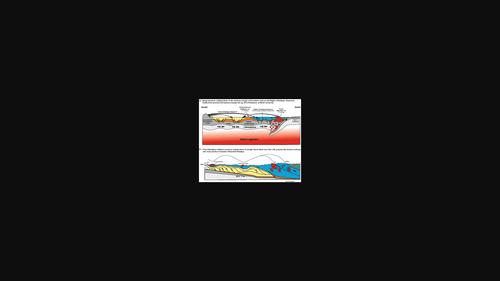当前位置:
X-MOL 学术
›
Geolog. J.
›
论文详情
Our official English website, www.x-mol.net, welcomes your feedback! (Note: you will need to create a separate account there.)
Geochemistry and U–Pb zircon geochronology of the Jutogh Thrust sheet, Himachal Pradesh, NW-Himalaya: Implications to the petrogenesis and regional tectonic setting
Geological Journal ( IF 1.8 ) Pub Date : 2022-09-06 , DOI: 10.1002/gj.4583 Paramjeet Singh 1 , Pratap Chandra Sethy 1 , Athokpam Krishnakanta Singh 1 , Saurabh Singhal 1 , Ajay Kumar Maurya 1 , Sarthak Ranjan Giri 2
Geological Journal ( IF 1.8 ) Pub Date : 2022-09-06 , DOI: 10.1002/gj.4583 Paramjeet Singh 1 , Pratap Chandra Sethy 1 , Athokpam Krishnakanta Singh 1 , Saurabh Singhal 1 , Ajay Kumar Maurya 1 , Sarthak Ranjan Giri 2
Affiliation

|
We present datasets of the whole-rock geochemistry and U–Pb zircon geochronology from the Jutogh Thrust (JT) sheet of eastern Himachal Pradesh, NW Himalaya, in order to explain the tectono-magmatic environment in which they formed. The metapelite and granitoids of the JT sheet have moderate to high SiO2, Al2O3, Na2O, K2O, and rare earth elements (REE). The A/CNK (Al2O3/CaO + Na2O + K2O) ratio with magnitudes ≥1, indicates the peraluminous nature, calc-alkaline series, and S-type granitoids. The high values of Rb and Th as compared to Nb and the negative Ba anomaly also suggest the dominance of crustal source material. The distinct enrichment of large-ion lithophile elements of Rb, Th, K, Ba and Pb and strong depletion in high-field-strength elements (HFSE) of Zr, Nb and Ti results in high incompatible elements/HFSE ratios, which suggest that the source is derived from many intra-crustal tectonic environments. All samples are well-fractionated REE patterns [(La/Yb)N = 6.06–17.37] and characterized by moderately flat enriched [(La/Sm)N = 2.31–4.71] of light rare earth elements. The negative Eu anomalies (Eu/Eu* = 0.18–0.71), suggest the plagioclase fractionation from the sourced magma and the origin of granitic gneiss through the high temperature (~800°C). The zircon U–Pb ages of granite range between 883.0 ± 15.0 Ma and 1260.0 ± 10.0 Ma, with a consistent peak of ~925.0 Ma. It confirms that the northern edge of the Indian Plate collided with an unnamed microcontinent. Also, in a contemporaneous process, the upper crust underwent partial melting, and the generated magma intruded in an extensional tectonic set-up of the northern edge (i.e., presently known as the Jutogh and Vaikrita thrust sheets) of the Indian Plate during the Neoproterozoic. The available zircon U–Pb ages of the JT sheet range between 550–2750 Ma. The magmatic nature of zircons, with two peaks of ~825 Ma and ~910 Ma, suggests that episodic magmatic processes have taken place during the Neoproterozoic. This study revealed that the Higher Himalayan Crystalline Sequence was a meta-sedimentary sequence and was deposited in an active margin set-up of the northern edge of the Indian Plate.
中文翻译:

Jutogh 逆冲断层的地球化学和 U-Pb 锆石年代学,喜马偕尔邦,喜马拉雅西北部:对岩石成因和区域构造背景的影响
我们展示了来自喜马拉雅西北喜马偕尔邦东部 Jutogh 逆冲断层 (JT) 的全岩地球化学和 U-Pb 锆石地质年代学数据集,以解释它们形成的构造-岩浆环境。JT 片的变泥质岩和花岗岩具有中高含量的SiO 2、Al 2 O 3、Na 2 O、K 2 O和稀土元素(REE)。A/CNK(Al 2 O 3 /CaO + Na 2 O + K 2O)比值≥1,表示过铝质、钙碱性系列、S型花岗岩。与 Nb 相比,Rb 和 Th 的高值以及负 Ba 异常也表明地壳源材料占主导地位。Rb、Th、K、Ba 和 Pb 等大离子亲石元素的显着富集以及 Zr、Nb 和 Ti 等高场强元素 (HFSE) 的强烈亏损导致高不相容元素/HFSE 比值,这表明来源来自许多地壳内构造环境。所有样品都是良好分馏的 REE 模式 [(La/Yb) N = 6.06–17.37],其特征是适度平坦富集 [(La/Sm) N = 2.31–4.71] 的轻稀土元素。负 Eu 异常 (Eu/Eu* = 0.18–0.71),表明来自源岩浆的斜长石分馏和高温 (~800°C) 花岗岩片麻岩的起源。花岗岩的锆石 U-Pb 年龄介于 883.0 ± 15.0 Ma 和 1260.0 ± 10.0 Ma 之间,一致的峰值为 ~925.0 Ma。它证实了印度板块的北部边缘与一个未命名的微大陆相撞。此外,在同时期的过程中,上地壳经历了部分熔融,在新元古代期间,产生的岩浆侵入了印度板块北缘(即目前称为 Jutogh 和 Vaikrita 逆冲断层)的伸展构造构造. JT 板的可用锆石 U-Pb 年龄范围在 550-2750 Ma 之间。锆石的岩浆性质,具有~825 Ma和~910 Ma的两个峰值,表明在新元古代期间发生了幕式岩浆过程。这项研究表明,高喜马拉雅结晶层序是一个变质沉积层序,沉积在印度板块北缘的活动边缘构造中。
更新日期:2022-09-06
中文翻译:

Jutogh 逆冲断层的地球化学和 U-Pb 锆石年代学,喜马偕尔邦,喜马拉雅西北部:对岩石成因和区域构造背景的影响
我们展示了来自喜马拉雅西北喜马偕尔邦东部 Jutogh 逆冲断层 (JT) 的全岩地球化学和 U-Pb 锆石地质年代学数据集,以解释它们形成的构造-岩浆环境。JT 片的变泥质岩和花岗岩具有中高含量的SiO 2、Al 2 O 3、Na 2 O、K 2 O和稀土元素(REE)。A/CNK(Al 2 O 3 /CaO + Na 2 O + K 2O)比值≥1,表示过铝质、钙碱性系列、S型花岗岩。与 Nb 相比,Rb 和 Th 的高值以及负 Ba 异常也表明地壳源材料占主导地位。Rb、Th、K、Ba 和 Pb 等大离子亲石元素的显着富集以及 Zr、Nb 和 Ti 等高场强元素 (HFSE) 的强烈亏损导致高不相容元素/HFSE 比值,这表明来源来自许多地壳内构造环境。所有样品都是良好分馏的 REE 模式 [(La/Yb) N = 6.06–17.37],其特征是适度平坦富集 [(La/Sm) N = 2.31–4.71] 的轻稀土元素。负 Eu 异常 (Eu/Eu* = 0.18–0.71),表明来自源岩浆的斜长石分馏和高温 (~800°C) 花岗岩片麻岩的起源。花岗岩的锆石 U-Pb 年龄介于 883.0 ± 15.0 Ma 和 1260.0 ± 10.0 Ma 之间,一致的峰值为 ~925.0 Ma。它证实了印度板块的北部边缘与一个未命名的微大陆相撞。此外,在同时期的过程中,上地壳经历了部分熔融,在新元古代期间,产生的岩浆侵入了印度板块北缘(即目前称为 Jutogh 和 Vaikrita 逆冲断层)的伸展构造构造. JT 板的可用锆石 U-Pb 年龄范围在 550-2750 Ma 之间。锆石的岩浆性质,具有~825 Ma和~910 Ma的两个峰值,表明在新元古代期间发生了幕式岩浆过程。这项研究表明,高喜马拉雅结晶层序是一个变质沉积层序,沉积在印度板块北缘的活动边缘构造中。


























 京公网安备 11010802027423号
京公网安备 11010802027423号